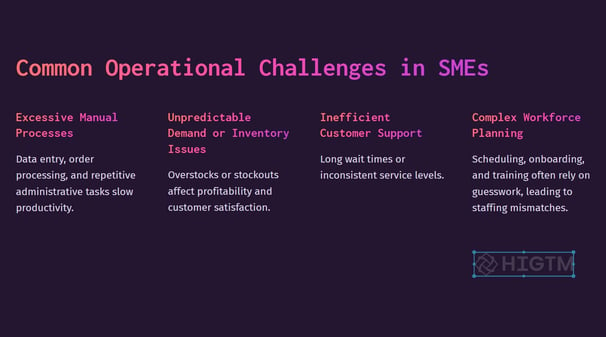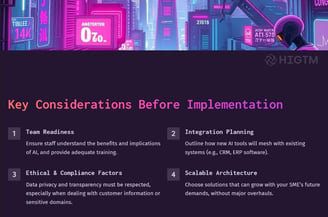8. Identifying Pain Points – Where AI Can Bring the Most Immediate Value
This post demystifies the process of pinpointing your most pressing pain points—operational bottlenecks and time sinks where AI can bring immediate, tangible value. By choosing strategic use cases, you’ll avoid pie-in-the-sky projects that fail to produce quick wins and risk team morale. Instead, we’ll outline common operational hurdles in SMEs, illustrate rapid-win AI scenarios, and provide a step-by-step guide to evaluating organizational readiness. Let’s delve into how you can zero in on high-impact AI targets that accelerate growth and efficiency.
Q1: FOUNDATIONS OF AI IN SME MANAGEMENT - CHAPTER 1 (DAYS 1–31): CORE AI CONCEPTS & VALUE PROPOSITION
Gary Stoyanov PhD
1/8/20256 min read

1. Why Pinpointing Pain Points Matters
1.1 Maximizing Resource Efficiency
For SMEs, funds and personnel bandwidth are typically limited. Rather than scattering efforts across multiple initiatives, focusing on specific, high-priority challenges allows you to channel resources effectively. By aligning AI with an immediate problem—like automating inventory checks or reducing manual data entry—you ensure that every dollar spent delivers measurable outcomes.
1.2 Faster ROI Through Targeted Solutions
Broad, unfocused AI deployments often end in confusion or stalled implementations. However, by selecting clear-cut, well-defined pain points, you can demonstrate early success—showing cost savings, reduced errors, or increased sales. These rapid wins create momentum, validating AI’s value and securing buy-in from teams and leadership for further investment.
1.3 Team Buy-In and Engagement
People gravitate toward solutions that solve real problems in their daily work. When employees see an AI chatbot instantly handling repetitive queries, or a predictive model reducing last-minute inventory issues, they appreciate the technology rather than viewing it as an abstract hype. This fosters openness to additional AI initiatives down the road.
2. Common Operational Challenges in SMEs
Every SME faces unique hurdles, but certain operational challenges recur across multiple sectors. Below are four common issues ripe for AI-driven fixes:
2.1 Excessive Manual Processes
The Issue: Data entry, order processing, and administrative tasks absorb valuable employee time, sometimes leading to boredom or repetitive strain errors.
AI Remedy: Automation tools—like intelligent document processing or robotic process automation (RPA)—handle routine tasks, enabling staff to focus on higher-level responsibilities.
Example: A small accounting firm implements an AI-based invoice scanning system. Instead of manually inputting amounts, due dates, and vendor details, employees simply review and approve automatically captured data—cutting the process from hours to minutes.
2.2 Unpredictable Demand and Inventory Management
The Issue: SMEs juggling product stock often face overstocking (tying up capital in excess inventory) or stockouts (leading to missed sales and unhappy customers).
AI Remedy: Machine learning models use historical sales data, seasonal trends, and market signals to forecast future demand. This allows precise reordering schedules—reducing wastage while maintaining sufficient stock.
Example: A boutique retailer deploys a predictive model analyzing past holiday season sales, online search behavior, and local event calendars. They cut leftover stock by 20% while boosting on-time deliveries during high-demand periods.
2.3 Inefficient Customer Support
The Issue: Long wait times, inconsistent service quality, and disorganized ticket handling can frustrate both staff and clients—jeopardizing brand loyalty.
AI Remedy: NLP-based chatbots or automated ticket-routing systems. Chatbots handle repetitive FAQs 24/7, while ticket-routing AI assigns complex queries to specialists efficiently.
Example: A subscription-based streaming service introduces a simple chatbot answering account reset questions or billing inquiries. Their support queue shrinks, and customer satisfaction climbs, as users get instant solutions to basic issues.
2.4 Complex Workforce Planning
The Issue: Scheduling, onboarding, and training often rely on guesswork—leading to understaffed peak periods or idle employees in slow times.
AI Remedy: Predictive analytics that map out upcoming labor needs, skill gaps, or seasonal staffing demands—ensuring the right people are in the right roles at the right moments.
Example: A mid-sized restaurant chain uses AI-driven scheduling to anticipate weekend surges. The model factors in local events, historical data, and weather. Managers reduce overtime costs and balance staffing more precisely, boosting staff morale.
3. Rapid-Win AI Use Cases
Once an SME identifies a pain point, the next step is choosing a manageable AI solution that addresses it quickly. Below are three rapid-win scenarios where smaller businesses often see immediate ROI:
3.1 Demand Forecasting & Inventory Management
Quick Win: Lower holding costs, fewer backorders, and improved cash flow.
Scenario: An online retailer uses historical sales data and simple regression models to forecast weekly product needs. They order precisely what’s required, minimizing stockouts and freeing capital previously tied up in excess inventory.
ROI Impact: Time saved on manual reorder calculations; cost savings in storage and waste.
3.2 Automated Lead Qualification
Quick Win: Sales teams concentrate on promising leads, rather than trawling large contact lists.
Scenario: A B2B consulting firm scores leads using engagement metrics (e.g., email opens, website visits) and demographics, flagging the highest potential buyers. This approach streamlines outreach, raises conversion rates, and decreases the time wasted on cold prospects.
ROI Impact: Increased sales productivity, higher deal closure rates.
3.3 Customer Service Chatbots
Quick Win: Routine inquiries resolved instantly, around the clock.
Scenario: An online subscription service sets up a chatbot handling 70% of support requests (password resets, billing queries). Complex issues are routed to human agents. Customer satisfaction rises as wait times plummet.
ROI Impact: Fewer support tickets for staff to manage, improved subscriber retention due to quick resolutions.
4. Techniques for Identifying the Right Pain Points
A structured approach ensures SMEs target the right challenges rather than jumping at flashy AI tools without a clear strategy. Below are three methods to map your most pressing issues:
4.1 Stakeholder Interviews
Method: Speak directly with department heads and frontline employees—customer support reps, sales leads, operations managers—to uncover recurring frustrations.
Outcome: A prioritized list of potential AI use cases aligned with genuine pain points. Engaging staff early also garners buy-in and unearths domain expertise crucial for solution design.
4.2 Data Availability Check
Method: Evaluate whether relevant data exists in a clean and accessible format. For instance, do you track historical sales daily? Is your CRM updated in real time? Can your production logs be integrated seamlessly?
Outcome: Realistic scope of what’s immediately feasible. If data gaps exist, you might need a short data collection or cleaning project first.
4.3 ROI Impact Analysis
Method: Estimate potential financial gains—like cost savings, revenue uplift, or resource time saved—along with intangible benefits such as improved customer experience or brand perception.
Outcome: A sorted list of AI projects by measurable benefits. Focus on projects that demonstrate quick, clear returns to build momentum for future expansions.
5. Key Considerations Before Implementation
Once you identify your top AI candidates, don’t rush headlong into coding or software purchases. Proper planning safeguards your project from unexpected pitfalls.
5.1 Team Readiness
Question: Do your employees understand how AI might change their roles? Are they supportive or wary?
Action: Provide trainings or workshops explaining how AI will free staff from repetitive tasks, letting them do more strategic or creative work.
5.2 Integration Planning
Question: How will new AI tools work alongside existing CRMs, ERPs, or e-commerce platforms?
Action: Draft an architecture diagram detailing data flow. If a chatbot is introduced, how does it feed user queries to your ticketing system? If you’re automating invoice processing, which financial software must it sync with?
5.3 Ethical & Compliance Factors
Question: Are you handling personal data responsibly? Do you comply with privacy regulations like GDPR?
Action: Implement transparent data policies. If you’re analyzing user behavior, inform customers about data usage, anonymize sensitive information, and maintain robust security protocols.
5.4 Scalable Architecture
Question: If your pilot works, can you scale it to handle more data, more customers, or additional departments without major overhauls?
Action: Opt for cloud services that can grow with your needs. Confirm that data pipelines can process increased loads, and design models to be modular—updating them is easier when your architecture is flexible.




6. Conclusion: Building Momentum through Targeted AI
Identifying urgent, high-impact pain points ensures your SME invests in AI solutions that immediately reduce costs, boost revenue, or enhance customer satisfaction. By focusing on common operational challenges—excessive manual tasks, unpredictable inventory, uneven customer support, or workforce planning—companies often see tangible returns within months rather than years.
Key Themes to Remember:
Aim at Real Problems: Solutions must address authentic bottlenecks—this secures buy-in and measurable results.
Rapid-Win Use Cases: Starting with targeted projects (predictive maintenance, automated lead scoring, or chatbots) demonstrates feasibility and ROI quickly, forging organizational confidence.
Assessment Matters: Stakeholder interviews, data readiness checks, and ROI estimates help you prioritize effectively, ensuring you tackle the right AI opportunities first.
Plan Implementation: Properly train your team, integrate data flows, maintain compliance, and ensure the final solution can grow with your business.
Think Forward: Once your first AI project proves its worth, scale those successes across other departments or challenges, gradually weaving AI into the fabric of your SME’s operations.
At HIGTM, we partner with SMEs to locate these high-potential pain points, develop tailored AI pilots, and integrate solutions ethically and scalably. By starting where AI can have the most immediate impact, your organization lays a foundation for broader innovation and stays agile in a rapidly shifting market.
After all, true AI success stems from pinpointing precise challenges and applying the right data-driven solutions—removing guesswork and focusing your resources where they matter most.
Turn AI into ROI — Win Faster with HIGTM.
Consult with us to discuss how to manage and grow your business operations with AI.
© 2025 HIGTM. All rights reserved.
